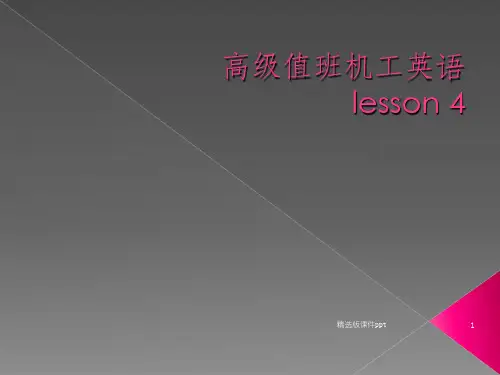(高级)值班水手英语听力与会话(ppt课件)(ppt,课件)
- 格式:ppt
- 大小:2.33 MB
- 文档页数:9

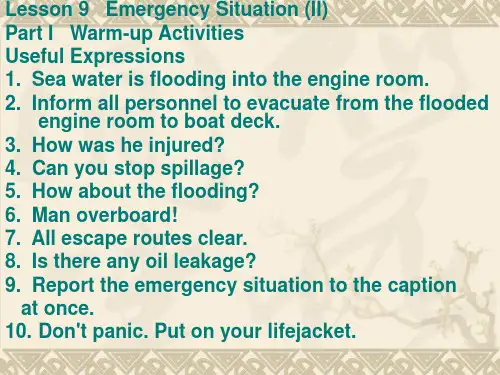
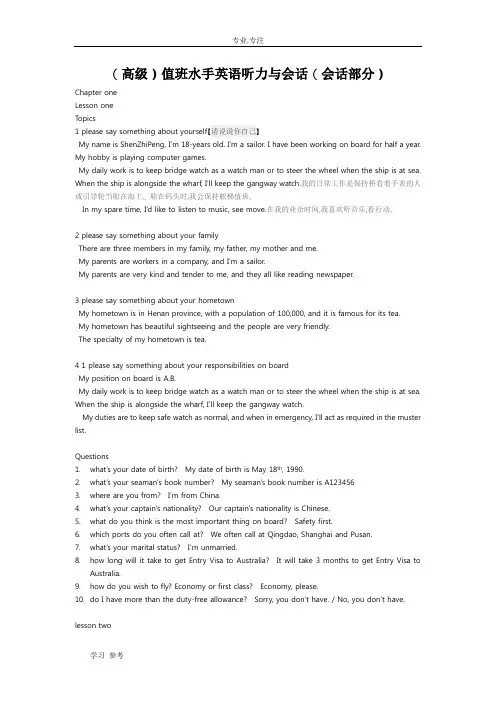
(高级)值班水手英语听力与会话(会话部分)Chapter oneLesson oneTopics1 please say something about yourself【请说说你自己】My name is ShenZhiPeng, I’m 18-years old. I’m a sailor. I have been working on board for half a year. My hobby is playing computer games.My daily work is to keep bridge watch as a watch man or to steer the wheel when the ship is at sea. When the ship is alongside the wharf, I’ll keep the gangway watch.我的日常工作是保持桥看着手表的人或引导轮当船在海上。
船在码头时,我会保持舷梯值班。
In my spare time, I’d like to listen to music, see move.在我的业余时间,我喜欢听音乐,看行动。
2 please say something about your familyThere are three members in my family, my father, my mother and me.My parents are workers in a company, and I’m a sailor.My parents are very kind and tender to me, and they all like reading newspaper.3 please say something about your hometownMy hometown is in Henan province, with a population of 100,000, and it is famous for its tea.My hometown has beautiful sightseeing and the people are very friendly.The specialty of my hometown is tea.4 1 please say something about your responsibilities on boardMy position on board is A.B.My daily work is to keep bridge watch as a watch man or to steer the wheel when the ship is at sea. When the ship is alongside the wharf, I’ll keep the gangway wa tch.My duties are to keep safe watch as normal, and when in emergency, I’ll act as required in the muster list.Questions1.what’s your date of birth? My date of birth is May 18th, 1990.2.what’s your seaman’s book number? My seaman’s book number is A1234563.where are you from? I’m from China.4.what’s your captain’s nationality? Our captain’s nationality is Chinese.5.what do you think is the most important thing on board? Safety first.6.which ports do you often call at? We often call at Qingdao, Shanghai and Pusan.7.what’s your marital status? I’m unmarried.8.how long will it take to get Entry Visa to Australia? It will take 3 months to get Entry Visa toAustralia.9.how do you wish to fly? Economy or first class? Economy, please.10.do I have more than the duty-free allowance? Sorry, you don’t have. / No, you don’t have.lesson twotopics1.say something about ship’s manningThe master is in command of the ship. The ship’s manning consists of three departments.The personnel of deck department includes the c/o, 2/o, 3/o, bosun, A.B. and O.S.The personnel of engine departments includes the C/E, 2/E, 3/E, 4/E, fitter, oilers and wiper.The personnel of service department includes the c/cook and the steward.2.say something about maritime agencies and the staff related to the ship.There are many maritime agencies, the MSA, harbour master, the agent, stevedores company, tally agency, and so on.The MSA supervising the maritime fares, the harbour master is in charge of the harbour and inbounding and outbounding vessels, the agent is to assist the master in going through the formalities, the stevedores load and discharge the cargo, and the tally agency is responsible for the tally work during cargo handling.3.say something about ship’s structures.In general, a ship is made up of two parts, the hull and the superstructure.The main body of a ship is the hull, it contains the E/R, cargo spaces and a number of tanks.The superstructure includes the forecastle, the bridge and the poop.Questions1.who is in command of the ship? Our captain is in command of the ship.2.generally speaking, how many officers are there in the deck department? There are 3 officers inthe deck department, they are c/o, 2/o and 3/o.3.what department does bosun belong to? Bosun belongs to the deck department.4.can you list some ship’s stores? The ship’s stores include the oil, water, paint, spare parts, and soon.5.can you list some ship’s tools? The ship’s tools include the scaling manchines, jett guns/ chisel,scrapers, chipping hammers, brushes, booms, and so on.6.what does “lifebuoy with light and smoke” mean? It means the man overboard lifebuoy, it’s usedin emergency when someone falls overboard.7.what does “cargo wire” mean? It’s the wires to lifting the cargo used in the derricks or crane s.8.what does “port side” mean? It means the left hand side of the ship.9.what is “board sling” used for? It is used to carry the general cargoes during cargo handling.10.can your list some ship’s bridge equipments? The ship’s bridge equipments includes th e wheel,telegraph, radar, GPS, AIS, gmdss equipments, and so on.Chapter twoLesson oneTopicsWhat procedures should be taken when you receive helm orders as a helmsman?The helmsman should take three procedures orderly when he receives the helms orders, that is to repeat, carry out and report.The helmsman should answer the helm orders clearly and loudly.When the ship does not answer the wheel, the helmsman should report it immediately to the person giving the orders.Questions1.How many orders are included in standard ship orders? Can you list some? There are four ordersincluded in the standard ship orders. They are the helm orders, anchor orders, mooring and unmooring orders, and the engine orders.2.if you are ordered “port five”, how to reply and report? First repeat the order “port five” clearlyand loudly, then steer the wheel to port five position, when the rudder angle reaches “port five”, report to the commander “wheel is five to port, Sir.”3.if you are ordered “steady”, how to reply and report? First repeat the order “steady” clearly andloudly, and speak out the course on the compass when the order is given. then steer the wheel to keep the course steady on it. Then report, “steady on course XXX.”4.how does the rudder answer? The rudder answer well/ slowly./ No answer./sluggish.5.what is the course? Course XXX.Lesson twoTopicsPlease describe the line handling operations before berthing.When approaching the quay, the deckhands should prepare the heaving lines, the winches and the mooring lines. Keep sharp look out of the movement of the ship, and prevent the lines from fouling. Usually the spring lines are firstly sent ashore, and keep it in strain. Then send the other lines ashore. When the ship is in position, make fast all the lines.To prevent the lines from fouling, you should operate the winch step by step and keep the lines in good order.Questions1.what does “single up forward to breast line and spring” mean? That means to cast off all theother forward lines except for one breast line and a spring line.2.if you want to change the position of the head line forward for 3 meters, what do you say? Shiftthe head line 3 meters forward.3.if you want to heave tight the breast line, what should you say? Heave up the breast line. / T akein/Pick up the slack on the breast line.4.which order is an equivalent to “send out head line”? Pay out/Slack the head line.5.which order is an equivalent to “let go stern line”? Undo/ slack off the stern line.Lesson threeTopicsWhat measures should be taken if anchor dragging?Anchor dragging means the anchor can’t bring up the ship to the seabed/ground. To prevent anchor dragging, you should make full consideration of all the features of the anchor position before anchoring, work out the cable length, and make sure the ship is brought up when anchoring. When anchor dragging, we should inform the master, the engine room, c/o and other personnel involved. Announce the alarm on radio to the other ships in vicinity. And then heave up the anchor to drop itagain.Questions1.what does “anchor is foul” mean? It means the anchor chain is across.2.if the anchor has been heaved out of the ground and clear of the bottom, what do you report?Anchor is aweigh.3.if the anchor is secured firmly in sea bottom, what do you report? She is brought up.4.if there is no obstruction around the anchor before anchoring, what do you report? The bow isclear.5.when the anchor is heaved out of water and just above it, what do you report? The anchor is outof water.Lesson fourTopicsIf you are given engine orders, how should you reply and report?When engine orders given, first repeat it clearly and loudly, then ring the telegraph to the position ordered, when the revolution commanded of the engine is obtained, report it to the commander. Such as “dead slow astern”, that means to keep the ship run astern very slowly. When the order is given, repeat it “dead slow astern”, then ring the telegraph to the “dead slow stern” position., when the revolution is obtained, report “engine is dead slow astern, sir.”Questions1.If you are ordered “stand by both engines”, how should you reply and report? First repeat isclearly and loudly, then inform the engine room to get the both engines ready for use. When you receive the notice from the E/R that both engines are ready, you should report it to the commander, “both engines are ready, Sir.”2.if you are ordered “full ahead”, how should you reply and report? When the order is given, repeatit “full ahead”, then ring the telegraph to the “full ahead” position., when the revolution required is obtained, report “engine is full ahead, sir.”3.if you are ordered “ring off engine”, how should you reply and report? When the order is given,repeat it “ring off engine”, then ring the telegraph to the max imum position., when the revolution required is obtained, report “engine is rung off , sir.”4.if you are ordered “stop engine”, how should you reply and report? When the order is given,repeat it “stop engine”, then ring the telegraph to the “stop” positi on., when the revolution reaches zero, report “engine is stopped, sir.”5.what does “finished with engine” mean? That means the movement of the engine is no longerrequired.Chapter threeQuestion1.Are you the sailor on duty/ watch? Yes, I am.2.Is your chief officer on board? Yes, he is.3.Would you show me the way? Yes, my/ with pleasure. This way, please.4.Our master is not on board, please wait a moment. I’ll call him back. O.K., thank you.5.When will your captain come back? He will be back in half an hour.6.The gangway/ accommodation ladder is too high. I’ll lower it a bit more/ a little bit.7.Would you please take me to see your captain? Yes. Follow/ After me, please.8.I am the relieving/ in-coming third officer, here is my ID card. O.K. please sign here.9.The head line is too tight. I’ll slack it. /Ease the strain on it.10.What’s your draft fore and aft? The draft is 6.90 meters, on even keel. //DESIMALChapter fourLesson oneQuestion1.Are holds clean? Yes, they are.2.Are holds dry? Yes, they are.3.Are holds free of smell? Yes, they are.4.Close hatch covers and report. Close the hatch covers. The hatch covers are closed, Sir.5.Lower down and secure all derricks. Lower down and secure all derricks. All derricks aresecured,Sir.Lesson two1.How many holds do you have? We have 5 holds.2.What is size of hatch openings? It’s 16X/by 25 square meters.3.What is safety load of Hold No. 2? The safety load of Hold No.2 is 5 tons per square meter.4.Are dockside cranes available? Yes, they are.5.What is length (width, depth) of Hold No.1? The length (width, depth) of Hold No.1 is 40 (30, 15)meters.Chapter fiveTopics1.Describe the procedures of adjusting derricks. The derrick is made up of derrick itself, winch,guys, hook and riggings. First, unlash the derrick, then operate the derrick as required, such as topping, lowering or swinging. Remember safety first, and operate it steadily. Do not exceed the safe working load of the derrick.2.Describe the proper way of using derricks. Remember safety first, and operate it steadily. Do notexceed the safe working load of the derrick. Do not swing it when the cargo is not being hoisted up.Questions1.What does “Union purchase” mean? “Union purchase” means handling the same sling by twoderricks at the same time.2.What does “SWL” stand for?/ represent “SWL” stands for safe working load.3.What cargo does a jumbo boom or heavy derrick used for lifting? A jumbo boom or heavyderrick used for lifting heavy cargo.4.Who usually adjust the derricks during the loading and discharging? During the loading anddischarging, the stevedores adjust the derricks usually.5.How many derricks are there at each hold? There is one derrick at each hold. /One for each.6.Before adjusting the derrick, what work should be done? Before adjusting the derrick, you shouldmake sure that the power is on and that the derrick is clear of obstructions.7.If the derrick is overloaded, what will happen? The cargo wire or the derrick will break up, andmaybe hurt persons.8.If the derrick is too high and can’t get to the cargo in the hold, how do you adjust it? Lower thederrick and pay out more cargo wire.Chapter sixTopics1.Say something about cargo carried on a ship. Generally speaking, the cargo includes dry cargoand liquid cargo. Dry cargo includes general cargo, cargo in bulk, cars, containered cargo, etc.Liquid cargo includes oil, LNG & LPG, chemical, and so on. The principal of cargo stowage is to ensure the safety of the ship and cargo.2.Preparations for loading cargo on board ship. Before loading cargo, we should get the shipready for loading, the preparation includes cleaning the cargo holds, decks, preparing dunnage, and derricks or cranes if fitted, and so on.Questions1.What does “SWL” stand for? “SWL” stand for safe working l oad.2.What equipment can be used to load cargo? It depends on the cargo to be loaded. The loadingequipment includes deck cranes, derricks, shore cranes, convey belt, loading machines, crabs, and so on. .3.What can be used to cover bilge before loading? Mattress, 麻布片?4.What can be used to separate cargo in a hold? Dunnage. Such as plank, canvas, mattress, wires,and so on.5.Who do the work of loading and unloading? The stevedores do.6.Where shall we stow cargo on a vessel? It depends on the type of ship, the cargo,the sequenceof discharging and the shiper’s requirement. Usually, the cargo is stowed in holds or tanks.Chapter sevenTopicsDescribe the importance of lashing and securing operation.The lashing and securing operation means to fix the cargo to holds and prevent them to move or shift during the voyage. It’s very important job onboard vessel, especially for general cargo. As we know, the ship will roll and pitch at sea, if the cargo is not well lashed and secured, the cargo will move or shiftin the hold to cause cargo damage, and even more to affect the stability of the ship so as to cause vessel listing or capsizing.Questions1.What does “jettison of cargo” mean? “jettison of cargo” mean to drop some cargo overboard inemergency for the safe of the ship and cargo on board and for the mutual interests of the parties involved.2.What shall be ensured before entering the enclosed space? Before entering the enclosed space,we should complete the check list, check the air for oxygen and toxic gas, and check the equipments to be used to ensure that it is safe to enter the enclosed space. And the approval from the master and the chief officer is essential.3.What does “shifting cargo” mean? “shifting cargo” means that the cargo moves in the holdswhen the ship is at sea.4.Can you list some lashing and securing equipment? Please list some. Yes, I can list some lashingand securing equipment. The lashing and securing equipments are the lashing ropes or wires, shackles, turnbuckles, chocks, wedges, and so on.5.When is the lashing work done? The lashing work should be done during and after the loadingoperation, and should be completed before sailing.6.When is the unlashing work done? The unlashing work should be done before discharging.Chapter eightQuestions1.What should be prepared before the pilot comes on board? Before the pilot comes on board, weshould get ready of pilot ladder, heaving line, lifebuoy, outside lighting at night, and so on.2.What flag should be hoisted when a vessel requires a pilot? When a vessel requires a pilot, theflag “G” should be hoist.3.What ship’s particulars does pilot station usually ask for? Pilot station usually ask for the ship’sparticulars of ship’s name, call sign, nationality, cargo, drafts, last port of call, and so on.4.What kind of things to be report to the pilot station? There so many things to be report to thepilot station, such as ship’s name, call sign, nationality, cargo, drafts, last port of call, and so on.5.What should be confirmed from the pilot station? The followings should be confirmed from thepilot station, such as the way of boarding, boarding time and position, the requirements about the pilot ladder if needed.6.What does “underway” mean? “underway” mean the ship is not at anchor, berthed, or made fastto shore.7.What must always be brought and placed close to the pilot ladder well before the pilot’sembarkation? Before the pilot’s embarkation, the heaving line, lifebuoy, and outside lighting, must always be brought and placed close to the pilot ladder.8.What flag should be hoisted when the pilot has arrived on board? When the pilot has arrived onboard, the flag “H” should be hoist.Chapter nineTopics1.Cleaning and repair work onboard. The importance of the cleaning and repair work is to maintainthe ship in good condition for seaworthiness. Cleaning and repair work onboard includes clean the deck, holds, engine room and accommodation, and some repair to moving parts. The work should be done as planned. And some must be daily done.2.Painting work used on board. The basic types of paint used on board include primer, coating,varnish and so on. Before painting, the surface should be well prepared, free of stains or rust, dry, and free of dirt.Questions1.Can you list at least three kinds of paint? Yes, I can. They are primer, undercoats, top coats,varnish, and so on.2.What kind of paint is usually given to the ship’s funnel? Heat-resistant paint is usually given tothe ship’s funnel.3.What type of paint do you use on deck? We used non-slip paints on deck.4.What paint is used for woodwork? Varnish is used for woodwork.5.Before repainting an area, what preparations do you make? Before repainting an area, the areamust be cleaned and washed to remove the salt, dirt and oil. Loose paint and scale to be removed.6.How do you remove the heavy rust on the plates? We use chipping hammer to remove the heavyrust on the plates.7.What repair work do the sailors usually do on board? Cleaning and greasing.Chapter tenC h a p t e r T e nShipboard Safe Navigational WatchT o p i c s1.The duties of the able seafarer on watch when underway.a) General rules as to watch-keeping.The able seafarer shall make regular checks to ensure that the ship navigates safety.b) Items to be checked at each watch.I t e m s t o b e c h e c k e d a s f o l l o w s:p o s i t i o n,c o u r s e,s p e e d a n d d r a u g h t o f t h e s h i p,w i t h t h e o t h e r ssuch as tides, current, weather, visibility and so on.2.The bridge shift change.a)The procedures for the bridge shift change.1) The officers and sailors often change their shifts once every 4 hours on the bridge.2) T h e r e l i e v i n g o f f i c e r s h o u l d c o m e o n t o t h e b r i d g e 15 m i n u t e s e a r l i e ri n o r d e r t o g e t f a m i l i a r with the circumstances. The handing over officer shall introduce the circumstances at present suchas the sh ip’s position, course, speed, vessels in the vicinity, sea state, wind state, etc. the relieving officer should check the navigational equipments and the ship’s route.b)Special attention for shift change.T h e s p e c i a l a t t e n t i o n f o r s h i f t c h a n g e i s h a n d o v e r t h e w o r k c o n t e n t s u n d e r s t a n d i n g v e r y c l e a r l y between the both parties.Questions1.Who keeps navigational watches on the bridge at sea?The duty officer and the duty sailor.2.How many watches are there on the bridge a day?There are three watches.3.Who takes the navigational watch from 0800 to 1200 hours in the morning and evening?The third officer.4.Who takes the navigational watch from 0000 to 0400 hours in the day and night?The second officer.5.What is the duty of the able seafarer on watch on the bridge at sea?Ensure the ship navigating safety.6.What should the able seafarer being relieved say?I now have the watch.7.What should the relieving able seafarer say?Y ou now have the watch.8.What should a relieving able seafarer do after taking over the watch?They will watch on the bridge and do the duty of watch work.Chapter ElevenShip SecurityQuestions1.What cargo are you carrying on your ship?The general cargo.2.Who is responsible for the security training on your ship?SSO (ship security officer)3.Do you organize regular security trainings?Y e s,w e d o.4.Do you know about the main threats facing to the security officer?Encountering the pirates and the armed attacks.5.What means of Security Level 1?Means the easy class security.6.What means of Security Level 2?Means the middle class security.7.What means of Security Level 3?Means the highest class security.8.Do you understand the measures for the prevention of unauthorized access to the ship?Y es, I understand.9.Do you understand the identification of the restricted areas and measures for the prevention of unauthorized access to them?Y es, I understand.10.Do you have the special security facilities?Y e s,w e h a v e.C h a p te r T w e lv eQuestions1.Check the fire alarms and report.All fire alarms are operational.2.Check the portable extinguishers and report.All portable extinguishers are in position and operational3.Check the firemen’s outfits and report.All the firemen’s outfits are operational.4.Check the openings in all rooms and report.All the openings are operational.5.Check the fire area every 10 minutes for re-ignition and report. For several times 10 minutes checking there is no re-ignition.6.Report direction and distance of person in water.The person in water’s direction is 120 angles and 50 meters ahead.7.Check launching tracks and report.All the launching tracks are operational.8.Check working parts and report.All working parts are operational.9.Operate lifeboat engine and report.Lifeboat engine is operated.10.Pressure in the water pipe in cargo holds is too low. Increasing the pressure in the water pipe in cargo holds.。

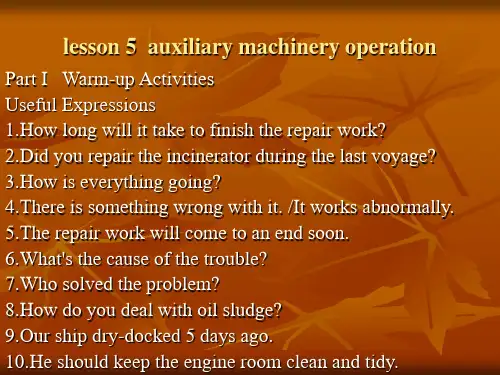
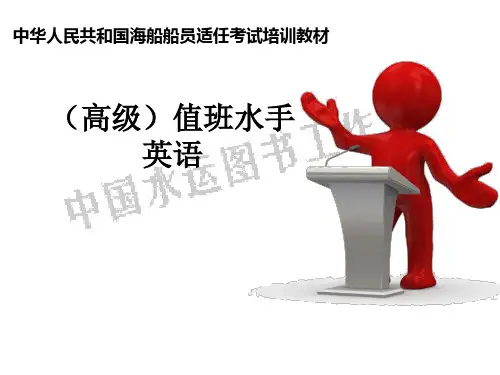

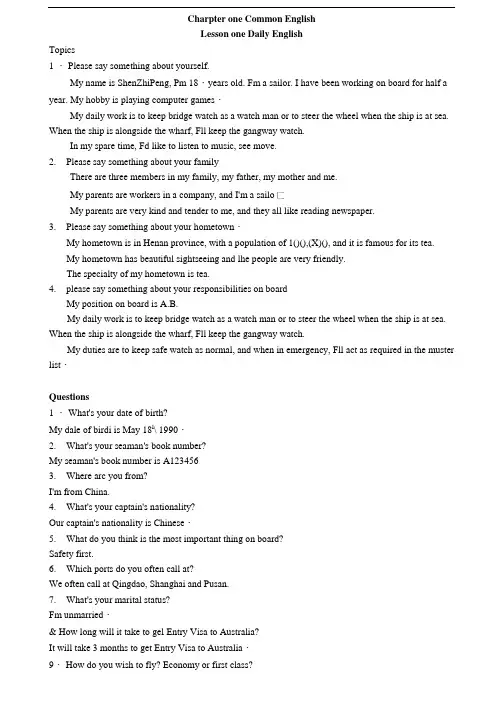
Charpter one Common EnglishLesson one Daily EnglishTopics1 ・ Please say something about yourself.My name is ShenZhiPeng, Pm 18・years old. Fm a sailor. I have been working on board for half a year. My hobby is playing computer games・My daily work is to keep bridge watch as a watch man or to steer the wheel when the ship is at sea. When the ship is alongside the wharf, Fll keep the gangway watch.In my spare time, Fd like to listen to music, see move.2.Please say something about your familyThere are three members in my family, my father, my mother and me.My parents are workers in a company, and I'm a sailo匚My parents are very kind and tender to me, and they all like reading newspaper.3.Please say something about your hometown・My hometown is in Henan province, with a population of 1()(),(X)(), and it is famous for its tea.My hometown has beautiful sightseeing and lhe people are very friendly.The specialty of my hometown is tea.4.please say something about your responsibilities on boardMy position on board is A.B.My daily work is to keep bridge watch as a watch man or to steer the wheel when the ship is at sea. When the ship is alongside the wharf, Fll keep the gangway watch.My duties are to keep safe watch as normal, and when in emergency, Fll act as required in the muster list・Questions1 ・ What's your date of birth?My dale of birdi is May 18l\ 1990・2.What's your seaman's book number?My seaman's book number is A1234563.Where arc you from?I'm from China.4.What's your captain's nationality?Our captain's nationality is Chinese・5.What do you think is the most important thing on board?Safety first.6.Which ports do you often call at?We often call at Qingdao, Shanghai and Pusan.7.What's your marital status?Fm unmarried・& How long will it take to gel Entry Visa to Australia?It will take 3 months to get Entry Visa to Australia・9・ How do you wish to fly? Economy or first class?Economy, please・10. Do I have more than the duty-free allowance?Sorry, you don't have・ / No, you don't have・Lesson Two Vocabulary Commonly Used on BoardTopics1 ・ Say something about ship's manningThe master is in command of the ship. The ship's manning consists of three departments.The personnel of deck department includes the c/o, 2/o, 3/o, bosun, A.B. and O.S.The personnel of engine departments includes the C/E, 2ZE, 3/E, 4/E, fitter, oilers and wiper.The personnel of service department includes the c/cook and the steward・2.Say something about maritime agencies and the staff related to the ship.There are many maritime agencies, the MSA, harbor master, the agent, stevedores Company, tally agency, and so on.The MSA supervising the maritime fares, the harbor master is in charge of the harbour andinbounding and outbounding vessels, the agent is to assist the master in going through theformalities, the stevedores load and discharge the cargo, and the tally agency is responsible for the tally work during cargo handling・3.Say something about ship's structures.In general, a ship is made up of two parts, the hull and the superstructure・The main body of a ship is the hull; it contains the E/R, cargo spaces and a number of tanks.The superstructure includes the forecastle, the bridge and the poop・Questions1 ・ Who is in command of the ship?Our captain is in command of the ship.2.Generally speaking, huw many ulliccrs arc llicrc in the deck dcparlincnl?There are 3 officers in the deck department; they are c/o, 2/o and 3/o.3・ What department does bosun belong to?Bosun belongs to the deck department.4.Can you list some ship's stores?The ship's stores include the oil, water, paint, spare parts, and so on.5.Can you list some ship's tools?The ship's tools include the scaling machines, jet guns/ chisel, scrapers, chipping hammers, brushes, booms, and so on.6.What does "lifebuoy with light and smoke" mean?It means the man overboard lifebuoy, it's used in emergency when someone falls overboard・7.What does "cargo wire" mean?1(、s the wires to lifting the cargo used in the derricks or cranes・& What does “port side" mean?It means the left hand side of the ship.9.What is "board sling" used for?It is used to carry the general cargos during cargo handling.1(). can your list some ship's bridge equipments?The ship's bridge equipments include the wheel, telegraph, radar, GPS, AIS, GMDSS equipments, and so on.Chapter two Ship's OrdersLesson one Helm OrdersTopicsWhat procedures should be taken when you receive helm orders as a helmsman?The helmsman should take three procedures orderly when he receives the helms orders, that is to repeat, carry out and report・The helmsman should answer the helm orders clearly and loudly.When the ship does not answer the wheel, the helmsman should report it immediately to the person giving the orders・Questions1 ・ How many orders are included in standard ship orders? Can you list some? There are four ordersincluded in the standard ship orders. They arc the helm orders, anchor orders, mooring andunmooring orders, and the engine orders.2.If you are ordered "port five", how to reply and report? First repeat the order “port five" clearly andloudly, then steer the wheel to port five position, when the rudder angle reaches “port five", report to the commander "wheel is five to port, Sir."3.If you are ordered "steady", how to reply and report? Hrst repeat the order "steady" clearly andloudly, and speak out the course on the compass when the order is given・ then steer the wheel to keep the course steady on it. Then report, "steady on course XXX."4.How does the rudder answer? The rudder answer well/ slowly./ No answe匚/sluggish・ 5・ Wlial is tlic course? Course XXX.Lesson two Mooring and Unmooring OrdersTopicsPlease describe the line handling operations before berthing・When approaching the quay, the deckhands should prepare the heaving lines, the winches and the mooring lines. Keep sharp look out of the movement of the ship, and prevent the lines from fouling.Usually the spring lines are firstly sent ashore, and keep it in strain. Then send the other lines ashore When the ship is in position, make fast all the lines・To prevent the lines from fouling, you should operate the winch step by step and keep the lines in good order.Questions1.What does "single up forward to breast line and spring" mean?That means to cast off all the other forward lines except for one breast line and a spring line・2.If you want to change the position of the head line forward for 3 meters, what do you say? Shift the head line 3 meters forward・3.If you want to heave tight the breast line, what should you say? Heave up the breast line・ / lakein/Pick up the slack on the breast line・4.Which order is an equivalent to "send out head line"?Pay oul/Slack the head line.5.Which order is an equivalent to Tel go stem line"?Undo/ slack off the stem line・Lesson Three Anchor OrdersTopicsWhat measures should be taken if anchor dragging?Anchor dragging means the anchor can't bring up the ship to the seabed/ground・ To prevent anchor dragging, you should make full consideration of all the features of the anchor position before anchoring, work out the cable length, and make sure the ship is brought up when anchoring. When anchor dragging, we should inform the master, the engine rooiru c/o and other personnel involved. Announce the alarm on radio to the other ships in vicinity. And then heave up the anchor to drop it again.Questions1 ・What does “anchor is foul" mean?It means the anchor chain is across・2.If lhe anchor has been heaved out of the ground and clear of the bottom, what do you report? Anchor is aweigh・3.If the anchor is secured firmly in sea bottom, what do you report?She is brought up.4.If there is no obstruction around the anchor before anchoring, what do you report?The bew is clear.5.When die anchor is heaved out of waler and just above il, what du you report? The anchor is out of water.Lesson Four Engine OrdersTopicsIf you arc given engine orders, how should you reply and report?When engine orders given, first repeat it clearly and loudly, then ring the telegraph to the position ordered, when the revolution commanded of the engine is obtained, report it to the commander. Such as "dead slow astern", that means to keep the ship run astern very slowly. When the order is given, repeat it "dead slow astern", then ring the telegraph to the "dead slow stem M position., when the revolution is obtained, report "engine is dead slow astern, sir."Questions1.If you are ordered "stand by both engines': how should you reply and report?First repeat is clearly and loudly, then inform the engine room to get the both engines ready for use. When you receive the notice from the E/R that both engines are ready, you should report it to thecommander, "both engines are ready, Sir."2.If you are ordered "full ahead", how should you reply and report?When the order is given, repeat it "full ahead", then ring the telegraph to the "full ahead" position., when the revolution required is obtained, report "engine is full ahead, sir."3.If you are ordered “ring off engine': how should you reply and report?When the order is given, repeat it "ring off engine", then ring the telegraph to (he maximum position, when the revolution required is obtained, report “engine is rung off, sir.^4.If you are ordered "stop engine'; how should you reply and report?When the order is given, repeat it "slop engine59, then ring the telegraph to the "stop" position, when the revolution reaches zero, report "engine is stopped, sir."5.What does "finished with engine" mean?That means the movement of the engine is no longer required・Chapter Three Keeping Watch at the GangwayQuestion1 ・ Are you the sailor on duty/ watch? Yes, I am.2.Is your chief officer on board? Yes, he is.3.Would you show me the way? Yes, my/ with pleasure・ This way, please.4.Our master is not on board, please wail a moment. Fll call him back. O.K., thank you.5.When will your captain come back? He will be back in half an hour.6.The gangway/ accommodation ladder is too high. Fll lower it a bit more/ a little bit.7.Would you please take me to see your captain? Yes. Follow/ After me, please・8・ I am the relieving/ in-coming third officer, here is my ID card・ O.K. please sign here・9.The head line is too tight. I'll slack it. /Ease the strain on it.10.What's your draft fore and aft? The draft is 6.90 meters, on even keel. //DES IM ALChapter Four Opening and Closing Hatches Lesson One Keeping Watch on the Cargo Operation Questions1 ・ Are holds clean? Yes, they are.2.Are holds dry? Yes, they are.3.Are holds free of smell? Yes, they are.4.Close hatch covers and report・ Close the hatch covers・ The hatch covers are closed, Sir.5.Lower down and secure all derricks・ Lower down and secure all derricks・ All derricks aresecured, Sir.Lesson two Opening and Closing Hatches Questions1.How many holds do you have? Wc have 5 holds.2.What is size of hatch openings? It's 16X/by 25 square meters.3.What is safety load of Hold No. 2? The safety load of Hold No.2 is 5 tons per square meter.4.Are dockside cranes available? Yes, they are.5.What is length (width, depth) of Hold No」?The length (width, depth) of Hold No」is 40 (30, 15)meters.Chapter Five Adjusting DerricksTopics1.Describe the procedures of adjusting derricks・The derrick is made up of derrick itself,winch, guys, hook and nggings・ First, unlash the derrick, then operate the derrick as required, such as topping, lowering or swinging. Remember safety first, and operate it steadily. Do not exceed the safe working load of the derrick・2.Describe the proper way of using derricks・ Remember safety first, and operate it steadily. Do notexceed the safe working load of the derrick. Do not swing il when the cargo is not being hoisted up.Questions1 ・What does 'Union purchase" mean? “Union purchase" means handling the same sling by two derricksat the same time・2.What does “SWL" stand for?/ represent "SWL" stands for safe working load.3.What cargo does a jumbo boom or heavy derrick used for lifting? A jumbo boom or heavy derrickused for lifting heavy cargo.4.Who usually adjust the derricks during the loading and discharging? During the loading anddischarging, the stevedores adjust the derricks usually・5.Huw many derricks arc llicrc al each hold? There is one derrick at each hold・ /One fur each.6.Before adjusting the derrick, what work should be done? Before adjusting the derrick, you shouldmake sure that the power is on and that the derrick is clear of obstructions.7.If the derrick is overloaded, what will happen? The cargo wire or the derrick will break up, and maybehurt persons・& If lhe derrick is too high and can't get to the cargo in the hold, how do you adjust it? Lower the derrick and pay out more cargo wire.Chapter Six Loading and Unloading OperationTopics1.Say something about cargo carried on a ship. Generally speaking, the cargo includes dry cargo andliquid cargo. Dry cargo includes general cargo, cargo in bulk, cars, containerized cargo, etc. Liquid cargo includes oil, LNG & LPG, chemical, and so on. The principal of cargo stowage is to ensure the safety of the ship and cargo.2.Preparations for loading cai^o on board ship. Before loading cargo, we should get the ship ready forloading, the preparation includes cleaning the cargo holds, decks, preparing dunnage and derricks or cranes if fitted, and so on.Questions1 ・ What does "SWL" stand for? "SWL" stand for safe working load.2.What equipment can be used to load cargo? It depends on the cargo to be loaded・ The loadingequipment includes deck cranes, derricks, shore cranes, convey belt, loading machines, crabs, and so on.・3.What can be used to cover bilge before loading? Mattress,麻布片?4.What can be used to separate cargo in a hold? Dunnage. Such as plank, canvas, mattress, wires, andso on.5.Who do the work of loading and unloading? The stevedores do.6.Where shall we stow cargo on a vessel? It depends on the type of ship, the cargo, the sequence ofdischarging and the shipper's requirement. Usually, the cargo is stowed in holds or tanks.Chapter Seven Lashing and Securing WorkTopicsDescribe the importance of lashing and securing operation.The lashing and securing operation means to fix the cargo to holds and prevent them to move or shift during the voyage・Il,s very important job onboard vessel, especially for general cargo. As we know, the ship will roll and pitch at sea, if the cargo is not well lashed and secured, the cargo will move or shift in the hold to cause cargo damage, and even more to affect the stability of the ship so as lo cause vessel listing or capsizing・Questions1.What does “jettison of cargo" mean?^jettison of cargo" mean to drop some cargo overboard in emergency for the safe of the ship and cargo on board and for the mutual interests of the parties involved・2.What shall be ensured before entering the enclosed space?Before entering the enclosed space, we should complete the check list, check the air for oxygen and toxic gas, and check the equipments to be used to ensure that it is safe to enter the enclosed space・ And the approval from the master and the chief officer is essential.3.What does "shifting cargo'。

